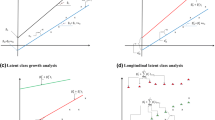Abstract
The present paper analyses the fertility histories of a sample of women within a stochastic framework. Recognising the sequential nature of reproductive decisions, the probability that a birth will occur at any given date is related to the realisations of past decisions and to all new information accrued since the last decision date, as well as to the characteristics of the potential mother. Time series are combined with survey data to provide information about the changing economic environment facing all women in the sample. The results of the analysis show the effects of wage rates, child benefits and various personal characteristics on birth probability profiles. The conclusions of the econometric analysis are related to existing theory and to the results of other empirical studies of the economic factors affecting the timing and spacing of births.
Similar content being viewed by others
References
Barmby TA, Cigno A (1988) A sequential probability model of fertility patterns. Hull Econ Res Pap 160
Becker G (1981) A treatise on the family. Harvard University Press, Cambridge London
Cigno A (1986) Fertility and the tax-benefit system: a reconsideration of the theory of family taxation. Econ J 96:1035–1051
Cigno A (1989) The timing of births: a theory of fertility, family expenditures and labour market participation over time. In: Wenig A, Zimmermann KF (eds) Demographic change and economic development. Springer, Berlin Heidelberg New York
Cigno A, Ermisch JF (1989) A microeconomic analysis of the timing of births. Eur Econ Rev 33:737–760
Cragg J, Uhler R (1970) The demand for automobiles. Can J Econ 3:386–405
Ermisch JF (1987) Econometric analysis of birth dynamics. Discussion Paper, Centre for Economic Policy Research, London
Heckman JJ, Willis RJ (1975) Estimation of a stochastic model of reproduction: an econometric approach. In: Terleckyj NE (ed) Household production and consumption. NBER Columbia University Press, New York
Hotz VJ, Miller RA (1986) The economics of family planning. Discussion Paper, Carnegie-Mellon University, Pittsburgh
McFadden D (1973) Conditional logit analysis of qualitative choice behaviour. In: Zarembka P (ed) Frontiers in econometrics. Academic Press, New York
Moffit R (1984) Optimal life cycle profiles of fertility and labour supply. Res Popul Econ 5:29–50
Newman J (1983) A stochastic dynamic model of fertility. Discussion Paper, Tulane University, New Orleans
Theewes J (1981) Family labour force participation: multinomial logit estimates. Appl Econ 13:481–498
Author information
Authors and Affiliations
Additional information
Thanks are due to Ermisch, Jurgen Doornik and anonymous referees for helpful comments, to Mrs Su Spencer for careful typing and also to the ESRC Data Archive for making available the data. All errors are, of course, ours.
Rights and permissions
About this article
Cite this article
Barmby, T., Cigno, A. A sequential probability model of fertility patterns. J Popul Econ 3, 31–51 (1990). https://doi.org/10.1007/BF00160416
Received:
Accepted:
Issue Date:
DOI: https://doi.org/10.1007/BF00160416




